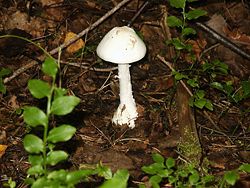Amanita virosa
Jump to navigation
Jump to search
For the course duration, the article is closed to outside editing. Of course you can always leave comments on the discussion page. The anticipated date of course completion is May 21, 2009. One month after that date at the latest, this notice shall be removed. Besides, many other Citizendium articles welcome your collaboration! |
 | ||||||||||||||||
| Scientific classification | ||||||||||||||||
| ||||||||||||||||
| Binomial name | ||||||||||||||||
Classification and naming
Amanita virosa or the European destroying angel is one of a group of deadly pure white mushroom species collectively known as the destroying angels or the death angels. Amanita virosa is one of the most poisonous of all known toadstools. It belongs to the fungi kingdom; a poisonous basidiomycete fungus, one of many in the genus Amanita.
Amanita virosa was first collected and described by Elias Magnus Fries a Swedish mycologist and botanist.
Description
Amanita virosa is pure white in appearance with gills which are usually not attached to the stalk.